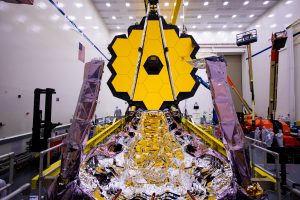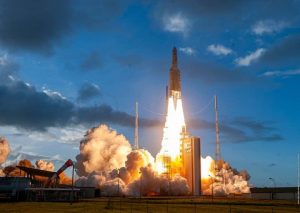We are getting ready to launch the biggest space telescope ever built – NASA’s James Webb Space Telescope. Its scientific promise is breathtaking. Discoveries ranging from imaging the first galaxies in the universe, analyzing the atmospheres of planets orbiting other stars in our galaxy, and even making discoveries in our solar system – the Webb space telescope is a dream come true for astronomers and science fans alike.

Later this year, we expect to see Webb leave our planet on an Ariane V rocket. I attended a launch a couple of days ago which used the same Ariane V vehicle design and launch-pad (see pic below). It was amazing.

For most missions, launch contributes the majority of mission risk – if the spacecraft is in space, most risk is behind us. There are few types of missions that are very much different with most risk coming *after* launch.
We have already performed one such mission in February when we landed on Mars. For the Perseverance rover, only 10-20% of the risk was retired during launch, perhaps 50% during the landing, and we are in the middle of the residual risk burn down as we are getting ready to drill and collect the precious Mars samples with the most complex mechanical system ever sent to another planet.
The second such mission this year is Webb. Like a transformer in the movies, about 50 deployments need to occur after launch to set up the huge system. With 344 so-called single point failures – individual steps that have to work for the mission to be a success – this deployment after launch will keep us on edge for 3 weeks or so. For comparison, this exceeds single point failures for landing on Mars by a factor of 3, and that landing lasted only 7 minutes.

Those who are not worried or even terrified about this are not understanding what we are trying to do. We have worked hard to build the team for this task and it has been a tough journey at times. This mission has a long story with chapters that required perseverance and strength. But the team is strong, and has overcome some of the toughest challenges, which leads us to today.
We are where we are because Webb has some of the best engineers and leaders I have ever met and they have continued when others were ready to give up. And now, they are closing off the final checkouts and folding the telescope for the last time on Earth. Webb is nearly ready to take flight. And that puts the team in position to set up this magnificent telescope one million miles from Earth!
I have been thinking about what I have learned since I have become part of the Webb team and it’s leader during the past 5 years. Here is the most important one: the power of purpose and hope!
I know each of my colleagues is different in how they handle this. Personally, I deal with the challenges of Webb and it’s scary aspects with focus on that future and think about it – all the time. And I think about how I can take that energy and help the team even more.

It is incredible how much power and energy can be derived from hope of achieving something totally worth it! And thinking about it and talking about it pulls us into this desirable future that seems so elusive at best.
Hope it is not an empty feeling and self illusion, it is locking onto the goal and not allowing anything to pull the attention off it! It is allowing this desirable future pull us towards it – step by step, together as an ever-improving team!
So, on Friday, when I watched and felt the Ariane 5 rocket lift into the clouds and disappear into the sky, I thought of the tremendous work and hope that will sit on top of a similar rocket later this year.
I can’t wait to see it leave Earth, finally. It is time for another shot at making history!
